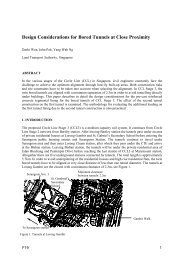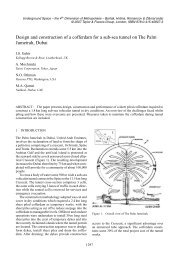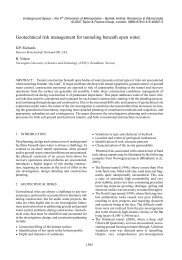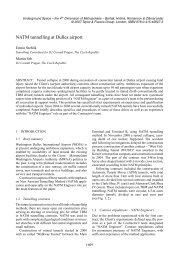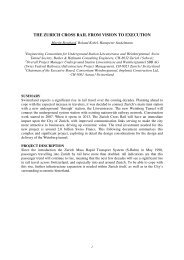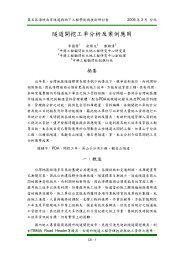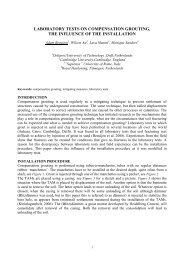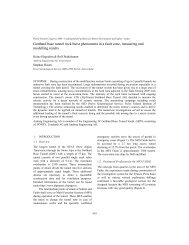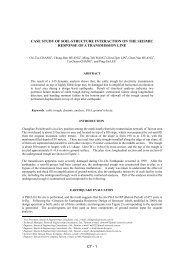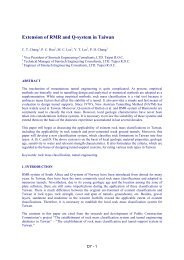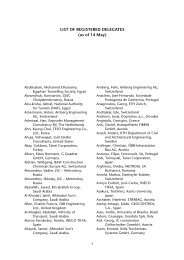Volume changes in grout used to fill up the tail void
Volume changes in grout used to fill up the tail void
Volume changes in grout used to fill up the tail void
You also want an ePaper? Increase the reach of your titles
YUMPU automatically turns print PDFs into web optimized ePapers that Google loves.
Table 1. Properties of <strong>the</strong> <strong>grout</strong> samples <strong>used</strong>.<br />
Parameter CG 2CG NCG Dim.<br />
Density 2109 1225 1840 Kg/m 3<br />
water content. 16 225 36.3 %<br />
D15 – – 0.0043 mm<br />
D50 – – 0.017 mm<br />
D85 – – 0.095 mm<br />
Conf. pressure 300 100 100 kPa<br />
<strong>Volume</strong> loss 8 3.5 4.5 %<br />
Permeability cake 4.10 −8 1.3.10 −8 1.6.10 −7 m/s<br />
A differential pressure gauge is attached <strong>to</strong> this cyl<strong>in</strong>der<br />
and a change <strong>in</strong> water level leads <strong>to</strong> a change <strong>in</strong> differential<br />
pressure. Changes <strong>in</strong> <strong>the</strong> water level also lead<br />
<strong>to</strong> pressure variations <strong>in</strong> <strong>the</strong> <strong>grout</strong>, but <strong>the</strong>se variations<br />
will be relatively small compared with <strong>the</strong> applied<br />
excess pressure of 1 bar. The conta<strong>in</strong>er with <strong>the</strong> <strong>grout</strong><br />
has an <strong>in</strong>side diameter of 0.284 m, <strong>the</strong> cyl<strong>in</strong>der on <strong>to</strong>p<br />
a diameter of 0.03 m. The height of <strong>the</strong> tube was 1 m.<br />
3 TESTS PERFORMED<br />
3.1 Bleed<strong>in</strong>g tests<br />
Three different types of <strong>grout</strong> were tested. A ‘traditional’cement<br />
based <strong>grout</strong> (CG), a 2-component <strong>grout</strong><br />
(2CG) and a <strong>grout</strong> mixture without cement (NCG) that<br />
gets <strong>the</strong> desired properties by choos<strong>in</strong>g <strong>the</strong> right gra<strong>in</strong><br />
size distribution of <strong>the</strong> granular material <strong>in</strong> <strong>the</strong> <strong>grout</strong>.<br />
The properties of <strong>the</strong> <strong>grout</strong>s selected and <strong>the</strong> volume<br />
stra<strong>in</strong>s that were found <strong>in</strong> <strong>the</strong> consolidation tests are<br />
summarized <strong>in</strong> Table 1. It should be noted that <strong>the</strong> volume<br />
stra<strong>in</strong> of <strong>the</strong> CG <strong>grout</strong> is higher than of <strong>the</strong> o<strong>the</strong>r<br />
2 but that this was also measured with a higher conf<strong>in</strong><strong>in</strong>g<br />
stress. For <strong>the</strong> same conf<strong>in</strong><strong>in</strong>g stress <strong>the</strong> difference<br />
will be smaller.<br />
As examples <strong>the</strong> results of <strong>the</strong> bleed<strong>in</strong>g tests for 2CG<br />
and NCG are shown <strong>in</strong> Figure 7 and Figure 8. These<br />
materials were tested with <strong>the</strong> set-<strong>up</strong> of Figure 5. The<br />
pressures are measured with <strong>the</strong> pressure transducers<br />
<strong>in</strong> <strong>the</strong> plate below <strong>the</strong> <strong>grout</strong>. The vane tests were not<br />
performed <strong>in</strong> <strong>the</strong>se tests.<br />
Although <strong>the</strong> 2 component <strong>grout</strong> has a certa<strong>in</strong><br />
strength with<strong>in</strong> a very short time (seconds) <strong>the</strong> volume<br />
decrease due <strong>to</strong> bleed<strong>in</strong>g cont<strong>in</strong>ues until 5 hours<br />
after <strong>the</strong> beg<strong>in</strong>n<strong>in</strong>g of <strong>the</strong> test. In <strong>the</strong> harden<strong>in</strong>g process<br />
that starts after approximately 5 hours <strong>the</strong> pore<br />
pressure decreases sharply until −100 kPa because <strong>the</strong><br />
water is bounded by <strong>the</strong> chemical reaction that leads<br />
<strong>to</strong> harden<strong>in</strong>g.<br />
With <strong>the</strong> pressure applied (100 kPa) <strong>the</strong> bleed<strong>in</strong>g of<br />
<strong>the</strong> NCG <strong>grout</strong> is only present for a period of approximately<br />
0.5 hour. S<strong>in</strong>ce <strong>the</strong>re is no chemical harden<strong>in</strong>g<br />
reaction with <strong>the</strong> water <strong>the</strong> pore pressure decreases<br />
until 0 kPa, but negative pressures are not found. The<br />
392<br />
<strong>Volume</strong> loss (%)<br />
5.5<br />
5.0<br />
4.5<br />
4.0<br />
3.5<br />
3.0<br />
2.5<br />
2.0<br />
1.5<br />
1.0<br />
0.5<br />
0.0<br />
<strong>Volume</strong> loss<br />
Pore pressure<br />
Total pressure<br />
0 5 10 15 20 25 30<br />
Time (hours)<br />
Figure 7. Result Bleed<strong>in</strong>g test for <strong>the</strong> <strong>grout</strong> 2CG.<br />
<strong>Volume</strong>loss(%)<br />
120<br />
100<br />
80<br />
60<br />
40<br />
20<br />
0<br />
-20<br />
-40<br />
-60<br />
-80<br />
-100<br />
5.0<br />
110<br />
4.5<br />
100<br />
4.0<br />
90<br />
3.5<br />
80<br />
3.0<br />
70<br />
2.5<br />
<strong>Volume</strong> loss 60<br />
2.0<br />
1.5<br />
Pore pressure<br />
Total pressure<br />
50<br />
40<br />
1.0<br />
30<br />
0.5<br />
20<br />
0.0<br />
10<br />
-0.5<br />
0<br />
0.0 0.1 0.2 0.3 0.4 0.5<br />
Time(hours)<br />
Figure 8. Result Bleed<strong>in</strong>g test for <strong>the</strong> <strong>grout</strong> NCG.<br />
Pressure (kPa)<br />
measured pore pressure is not <strong>in</strong> agreement with <strong>the</strong><br />
<strong>the</strong>ory of Bol<strong>to</strong>n & McK<strong>in</strong>ley (1997). Accord<strong>in</strong>g <strong>to</strong><br />
that <strong>the</strong>ory <strong>the</strong> pore pressure should rema<strong>in</strong> constant<br />
at 100 kPa until all material is consolidated. Dur<strong>in</strong>g<br />
<strong>the</strong> test it appears that <strong>the</strong> pore pressure at <strong>the</strong> bot<strong>to</strong>m<br />
of <strong>the</strong> sample already starts <strong>to</strong> decrease before <strong>the</strong> end<br />
of consolidation, show<strong>in</strong>g that <strong>the</strong> <strong>the</strong>ory is only an<br />
approximation of <strong>the</strong> real process.<br />
The 2-component <strong>grout</strong> was also tested on bleed<strong>in</strong>g<br />
properties us<strong>in</strong>g a standard oedometer test with a sample<br />
height of 0.02 m. In such a test <strong>the</strong> consolidation<br />
times are <strong>the</strong>oretically 100 times shorter than <strong>in</strong> a sample<br />
with a thickness of 0.2 m. Therefore <strong>the</strong> <strong>in</strong>fluence<br />
of <strong>the</strong> harden<strong>in</strong>g of <strong>the</strong> sample on <strong>the</strong> result will be less.<br />
This resulted <strong>in</strong> a much larger volume loss of around<br />
30%. This result shows that for <strong>grout</strong>s where <strong>the</strong> harden<strong>in</strong>g<br />
component is significant, <strong>the</strong> bleed<strong>in</strong>g has <strong>to</strong> be<br />
tested us<strong>in</strong>g a layer with a comparable thickness as is<br />
expected <strong>in</strong> <strong>the</strong> application, thus for <strong>tail</strong> <strong>void</strong> <strong>grout</strong>s<br />
this has <strong>to</strong> be <strong>the</strong> actual thickness of <strong>the</strong> <strong>tail</strong> <strong>void</strong>.<br />
3.2 Results tests without bleed<strong>in</strong>g<br />
The tests without bleed<strong>in</strong>g, with <strong>the</strong> set-<strong>up</strong> shown <strong>in</strong><br />
Figure 6, were only performed on <strong>grout</strong> type 2CG. One<br />
Pressure (kPa)



